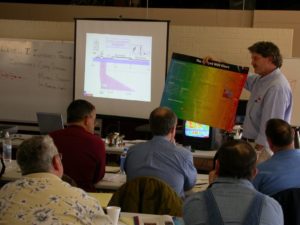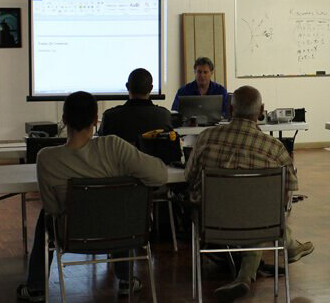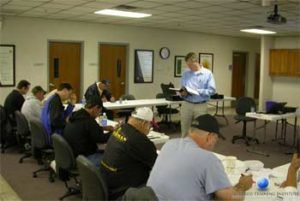Liquid Penetrant Inspection
Liquid Penetrant Inspection (LPI) is a widely used non-destructive testing technique for detecting surface-breaking defects in non-porous materials such as metals, plastics, and ceramics. The process involves cleaning the test surface, applying a visible or fluorescent liquid penetrant, allowing it time to seep into any surface flaws, and then removing the excess penetrant. A developer is then applied, which draws the trapped penetrant out of defects and creates visible indications under normal or ultraviolet light. LPI is highly effective for identifying cracks, porosity, seams, and other surface irregularities, especially in components where surface finish is critical. It is valued for its simplicity, low cost, and versatility across a wide range of industries, including aerospace, automotive, and manufacturing.
Airborne Ultrasonics
Airborne ultrasonics is a non-destructive testing (NDT) technique that utilizes high-frequency sound waves transmitted through the air to detect leaks, defects, or structural anomalies in a wide range of materials and systems. Unlike contact ultrasonic methods, airborne ultrasonics does not require direct contact with the test surface, making it especially useful for inspecting sealed systems, hard-to-reach areas, or components operating under pressure. The method works by detecting ultrasonic noise generated by turbulent airflow through leaks or by using an ultrasonic transmitter and receiver to identify changes in sound transmission caused by flaws such as cracks, gaps, or improper seals. Commonly applied in leak detection for tanks, pipelines, and HVAC systems, airborne ultrasonics provides a quick, efficient, and non-invasive means of assessing equipment condition and preventing failures.
Infrared thermography
Infrared thermography (IRT) is a non-destructive testing (NDT) technique that uses thermal imaging to detect and visualize temperature variations on the surface of materials. This method is particularly effective for identifying subsurface defects such as delaminations, voids, cracks, or moisture intrusion, which alter the thermal conductivity or heat flow in a material. IRT operates by capturing infrared radiation emitted by objects, which is then translated into a thermal image or thermogram. These images reveal abnormal temperature patterns that can indicate potential structural or functional issues without requiring direct contact or causing damage to the test object. Widely used in industries such as aerospace, civil engineering, and electrical maintenance, infrared thermography offers a fast, safe, and reliable means of evaluating component integrity and performance.
Leak Testing
Leak testing is a non-destructive testing (NDT) method used to detect and locate leaks in sealed systems or components by assessing the integrity of enclosures, vessels, or pipelines. The process involves introducing a test medium—such as air, gas, or liquid—into the system and monitoring for any escape through cracks, holes, or faulty seals. Various techniques are employed in leak testing, including pressure decay, bubble testing, tracer gas detection (e.g., helium or hydrogen), and mass spectrometry, depending on the sensitivity and application requirements. This method is crucial in industries like aerospace, automotive, medical device manufacturing, and energy, where even minor leaks can lead to performance issues, safety hazards, or environmental risks. Leak testing ensures product reliability and compliance with safety standards without damaging or altering the tested component.
Optical Gas Imaging
Non-destructive testing (NDT) using Optical Gas Imaging (OGI) is an advanced technique primarily used to detect and visualize gas leaks in industrial environments without disrupting operations or damaging equipment. OGI employs infrared cameras calibrated to specific wavelengths that correspond to the absorption characteristics of various gases, such as methane, sulfur hexafluoride, and volatile organic compounds. This allows inspectors to identify leaks in real time, even from a distance, enhancing both safety and efficiency. OGI is particularly valuable in the oil and gas, chemical, and power generation industries, where early detection of gas leaks can prevent hazardous incidents and environmental damage. As a non-contact and remote method, OGI offers a significant advantage over traditional leak detection tools by providing visual confirmation of gas emissions while maintaining the integrity of the inspected assets.
Visual Testing
Visual testing (VT) is the most fundamental and widely used non-destructive testing (NDT) method, relying on direct or enhanced visual inspection to detect surface-level defects such as cracks, corrosion, misalignment, and other discontinuities. It can be performed with the naked eye or with the aid of tools like magnifying glasses, borescopes, drones, or cameras for areas that are difficult to access. Despite its simplicity, visual testing is critical in quality control and preventive maintenance across industries such as construction, aerospace, manufacturing, and power generation. The effectiveness of VT largely depends on the inspector's skill, proper lighting, surface cleanliness, and access to the area being examined. As a first-line inspection method, visual testing is often used in conjunction with other NDT techniques to provide a comprehensive assessment of component integrity.





